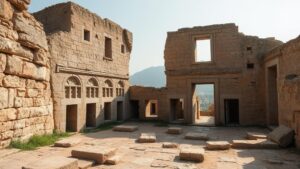Rediscovering forgotten ancient agricultural practices through tunnel systems.
Rediscovering Forgotten Ancient Agricultural Practices through Tunnel Systems
The quest for sustainable agriculture has led modern farmers and researchers to rediscover ancient agricultural practices, particularly those associated with tunnel systems initially utilized by ancient civilizations. These underground structures, engineered with remarkable ingenuity, offer valuable insights that can reshape contemporary farming techniques.
An Overview of Ancient Tunnel Systems
Tunnel systems have been utilized across various cultures for agricultural purposes. Notable examples include the qanat systems in Persia (modern-day Iran), the troglodyte vineyards in Tunisia, and the hypogean (underground) structures used by the Indus Valley civilization. e systems were designed not only for irrigation but also for temperature regulation, water conservation, and pest management, showcasing an understanding of natural resources that is still applicable in today’s climate crisis.
Historical Context: The Qanat System
The qanat system, originating around 1500 BCE, exemplifies the sophisticated engineering capabilities of ancient Persians. This system comprises underground tunnels that transport water from aquifers to the surface, where it can be utilized for irrigation. The gradient of these tunnels ensures a continuous flow of water, requiring minimal energy for distribution.
- Key Features of Qanat Systems:
- Typically 5-50 meters deep
- Can extend several kilometers
- Usage:
- Enabled agriculture in arid regions
- Supported local ecosystems
Cultivation in Troglodyte Vineyards
In Tunisia, underground troglodyte vineyards date back to the Roman era, where wine production was enhanced through controlled temperature and humidity levels within the tunnels. e unique features facilitate the growth of high-quality grapes, demonstrating an advanced understanding of microclimates.
Learning from the Indus Valley Civilization
The Indus Valley civilization, which thrived around 3300-1300 BCE in present-day Pakistan and northwest India, utilized hypogean structures for agriculture. These underground rooms helped in storing grains and protecting them from pests and environmental elements, hinting at a sophisticated approach to food security.
Modern Applications and Benefits
The revival of ancient practices like those seen in qanat and troglodyte systems has significant implications for modern agriculture, especially in regions facing water scarcity and climate change challenges. By implementing similar underground structures, contemporary farmers can achieve:
- Water conservation: Enhanced groundwater management reduces reliance on surface water, helping to preserve vital ecosystems.
- Temperature moderation: Underground structures maintain stable temperatures, mitigating the impact of extreme weather.
- Pest control: Reduced exposure to environmental factors can lower pest populations, diminishing the need for harmful pesticides.
Case Studies: Successful Integration of Tunnel Systems
Several modern projects have successfully integrated ancient practices into their agricultural models:
- The Qanat Project in Iran: Revitalization efforts have restored sections of ancient qanat systems, allowing farmers to tap into groundwater reserves without depleting surface water sources.
- Troglodyte Farms in Tunisia: Innovations in troglodyte vineyard management have led to increased grape yields, demonstrating that ancient knowledge can still be profitable today.
Addressing Concerns and Misconceptions
A common concern regarding the use of ancient agricultural practices is their scalability and relevance in modern farming. Critics often question whether these methods can meet the demands of contemporary agricultural production. But, the successful implementation of tunnel systems around the world shows that these techniques can be both adapted and scaled to fit modern needs without sacrificing sustainability.
Conclusion: A Path Forward
The challenge of feeding a growing global population amidst environmental uncertainty necessitates a reevaluation of agricultural practices. By looking back at ancient techniques, especially those involving tunnel systems, farmers can embrace innovative solutions that promote sustainability, efficiency, and resilience. As we uncover and adapt these historical practices, a new pathway emerges, reconnecting us with time-tested agricultural wisdom that can thrive in a modern context.
Incorporating forgotten knowledge not only enhances agricultural productivity but also evokes a sense of stewardship toward both our resources and our history. The future of farming may well lie beneath the surface, waiting to be rediscovered.



